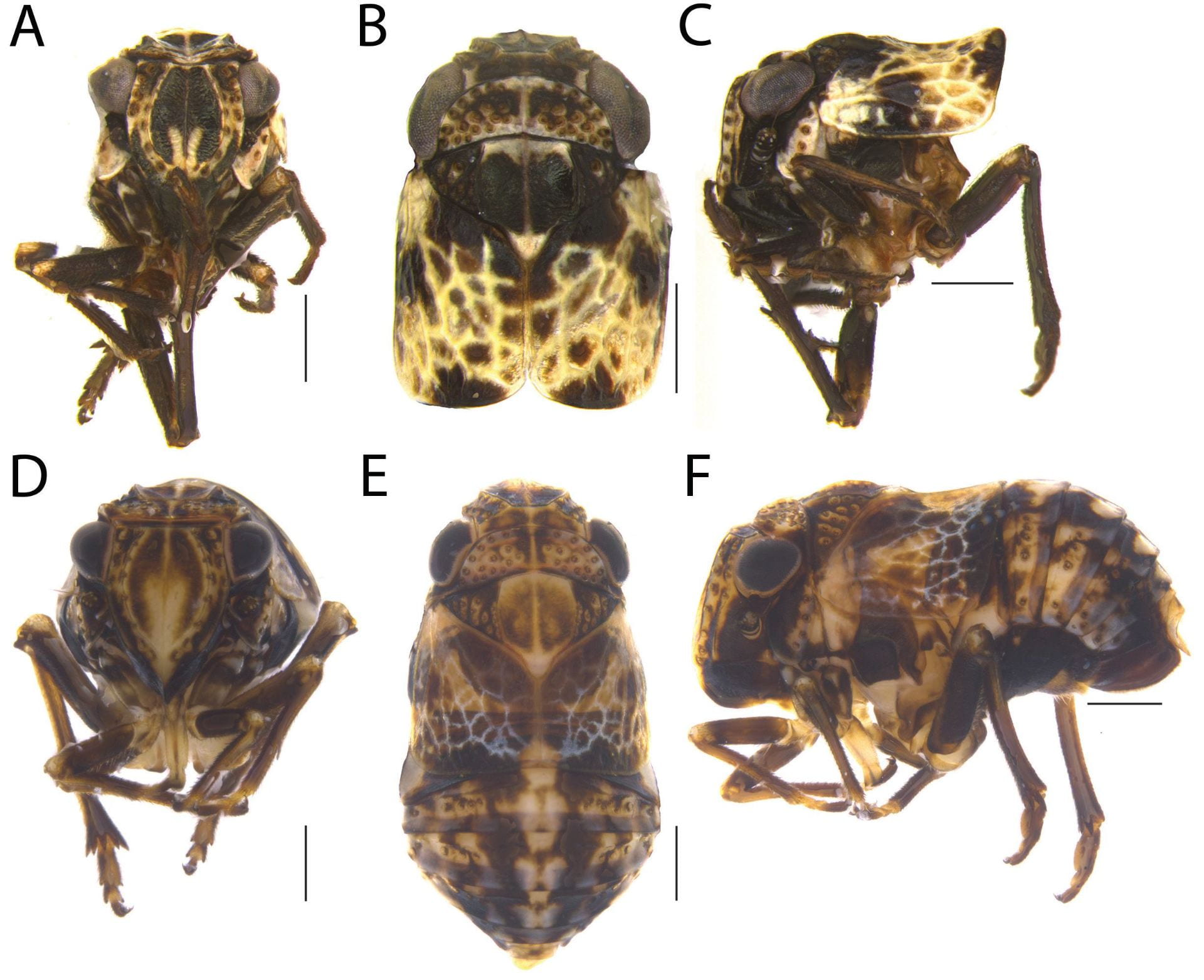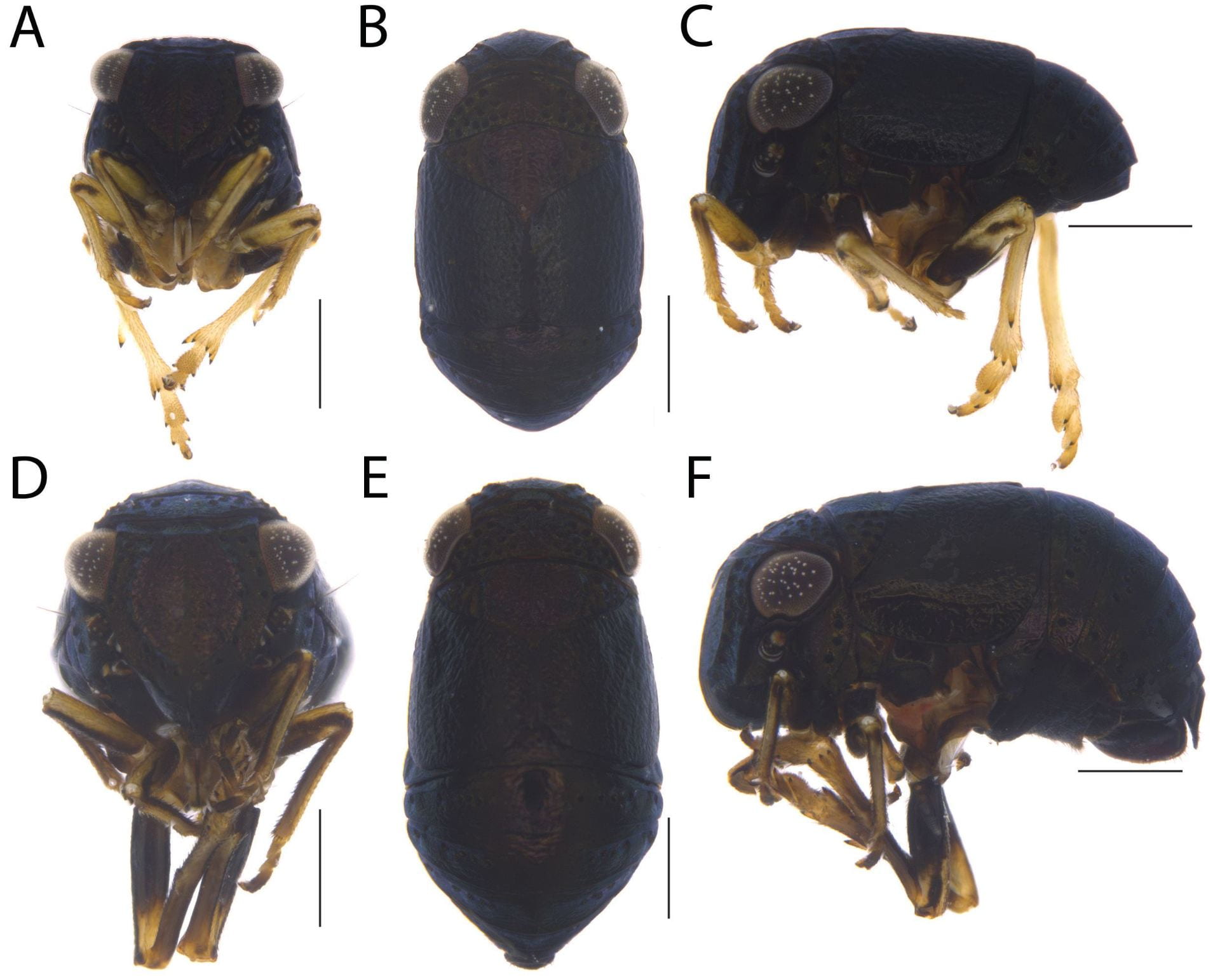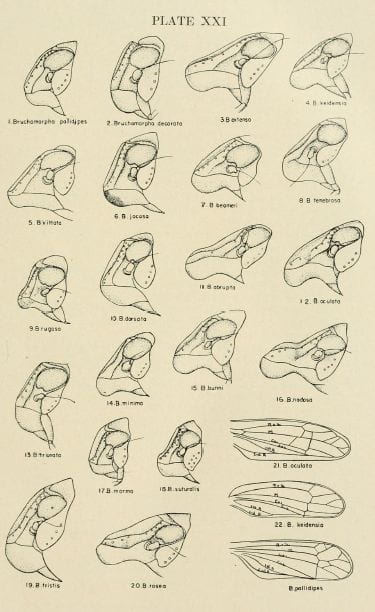[Back to Planthoppers of North America]
[Back to North American Caliscelidae]
Contents
- 1 Family Caliscelidae Amyot & Serville, 1843
- 1.1 Subfamily Caliscelinae Amyot & Serville, 1843
- 1.2 Tribe Peltonotellini Emeljanov, 2008
- 1.3 Genus Bruchomorpha Newman, 1838: 399.
- 1.4 Distribution
- 1.5 Recognized species
- 1.6 Economic Importance
- 1.7 Plant associations
- 1.8 Recognition
- 1.9 Online Resources
- 1.10 Collecting
- 1.11 Molecular resources
- 1.12 Selected references
Family Caliscelidae Amyot & Serville, 1843
Subfamily Caliscelinae Amyot & Serville, 1843
Tribe Peltonotellini Emeljanov, 2008
Genus Bruchomorpha Newman, 1838: 399.
Type species: Bruchomorpha oculata Newman, 1838: 399.
Synonyms
= Embolonia Provancher, 1889 (Type species Embolonia tricarinata Provancher, 1889: 252 (key), 253: syn. by Van Duzee 1912b: 327 (Embolonia tricarinata jr. syn. of Bruchomorpha oculata Newman, 1838).
Distribution
Widespread in US, Canada, and Central America.
Recognized species
There are 26 recognized species and several subspecies as follows:
Bruchomorpha abrupta Ball, 1935b – USA: CO, FL, GA, NM, OK, TX
Bruchomorpha beameri Doering, 1939: 106 – USA: AZ, CA, CO, MT, ND, WA; CAN: AB, BC, MB, SK
Bruchomorpha bunni Doering, 1939: 119 – USA: AZ, NM
Bruchomorpha costaricensis Schmidt, 1927 – Costa Rica
Bruchomorpha decorata Metcalf, 1923 – USA: AZ, NC, TX: Mexico (Durango, Federal District, Jalisco, Morelia, Nuevo León, San Luis Potosí, Sonora, Tabasco, Tamaulipas); Panama
Bruchomorpha decorata nihldecorata Caldwell, 1945 – Mexico (Sonora)
Bruchomorpha dorsata Fitch, 1856 – USA: AR, CA, CO, CT, GA, IA, IL, KS, MO, MS, NC, NJ, NY, OH, OK, PA, SC, SD, TX, WI; CAN: BC, MB, ON, SK (also “Dakota”)
= Bruchomorpha flavovittata Stål, 1862 synonym by Melichar (1906)
Bruchomorpha dorsolineata Caldwell, 1945 – Mexico (Nuevo Leon)
Bruchomorpha duocantha Caldwell, 1945 – Mexico (Coahuila, Michoacán, Federal District)
Bruchomorpha extensa Ball, 1935b – USA: AZ, CA, ID, KS, NC?, NM, OK, TX, UT
Bruchomorpha jocosa Stål, 1862a: 310 – USA: DC, FL, IA, IL, KS, KY, MO, MS, NC, NE, NJ, OK, SC, TX, VA, WI; CAN: MB, SK = Bruchomorpha jocosa var. craniata Ball, 1935b – USA: IA, KS, NE, WI
= Bruchomorpha jocosa var. obscura Ball, 1935b – USA: DC, FL, MS, NJ, VA
= Bruchomorpha bimaculata Dozier, 1928 synonym by Ball (1935)
Bruchomorpha keidensia Doering, 1939: 118 – CAN: AB, MB, SK
Bruchomorpha longipennis Caldwell, 1945 – Mexico (Michoacán)
= Bruchomorpha longipennis abbrata Caldwell, 1945 – Mexico (Michoacán)
Bruchomorpha mexicana Kirkaldy, 1913: 26 – Mexico (Morelos)
Bruchomorpha minima Metcalf, 1923 – USA: FL, GA, MS, NC
= Bruchomorpha mormo Ball, 1935: 198 [nec Kirkaldy, 1907] syn. by Doering 1940: 121.
Bruchomorpha minutiforma Caldwell, 1945 – Mexico (Guerrero, Morelos)
Bruchomorpha mormo Kirkaldy, 1907b – USA: AZ, TX; Mexico (Coahuila de Zaragoza) (reported in error: USA: NC)
Bruchomorpha nodosa Doering, 1939: 110 – USA: AZ, KS, LA, NE, OK, TX
Bruchomorpha oculata Newman, 1838: 399 – USA: AR, CO, CT, DC, DE, FL, GA, IA, IL, IN, KS, KY, MD, ME, MI, MN, MO, MS, NC, NE, NH, NJ, NM, NY, OH, OK, PA, SC, TN, TX, VA, VT, WI; CAN: ON, PE, QC
= Cephalelus americanus Provancher, 1872 synonym by Provancher 1889: 253.
= Embolonia tricarinata Provancher, 1889 synonym by Van Duzee (1912)
= Bruchomorpha oculata nasuta Stål, 1862a: 310; status by Ball 1935b: 201.
= Bruchomorpha nasuta Stål, 1862a; syn. by Doering 1939: 113-115.
= Bruchomorpha oculata var. nigrata Ball, 1935b – USA: FL
Bruchomorpha pallidipes Stål, 1862a: 309 – USA: AL, CO, DC, DE, FL, IL, KS, LA, MD, MO, MS, NJ, OH, NC, SC, VA
Bruchomorpha pseudodorsata De Freitas, Dietrich & Takiya, 2020 – Mexico Northeast (Coahuila)
Bruchomorpha rosea Doering, 1939: 111 – USA: AZ, NM, TX
*Bruchomorpha rugosa Metcalf, 1923 – USA: AZ, TX – this species moved to Fitchiella.
Bruchomorpha suturalis Melichar, 1906 – USA: AZ, CA, CO, NM, OK, TX (NC, FL, MS records in error)
Bruchomorpha tenebrosa Doering, 1939 – USA: FL
Bruchomorpha tristis Stål, 1862a: 309 – USA: AZ, CA, CO, CT, DC, FL, IA, IL, IN, KS, LA, MN, MT, NC, NE, NJ, NY, OH, OR, TX, WA, WI; CAN: AB, MB, ON, SK
Bruchomorpha triunata Ball, 1935b – USA: AZ
Bruchomorpha vittata Metcalf, 1923 – USA: TX
= Bruchomorpha bicolor Metcalf, 1923 syn. by Ball 1935: 198-199.
Economic Importance
Limited.
Plant associations
Presumably all of them are on grasses, the following associations are reported
- Bruchomorpha abrupta – Eragrostis curvula (Schrad.) Nees; (Weeping lovegrass; Poaceae (from Wilson & Wheeler 2010)
- Bruchomorpha bunni – Eragrostis curvula (Schrad.) Nees
- Bruchomorpha decorata – Setaria grisebachii E. Fourn. (as Chaetochloa grisebachii)
- Bruchomorpha dorsata – Eragrostis curvula (Schrad.) Nees
- Bruchomorpha jocosa – Eragrostis curvula (Schrad.) Nees
- Bruchomorpha nodosa – Eragrostis curvula (Schrad.) Nees
- Bruchomorpha oculata – Eragrostis curvula (Schrad.) Nees
- Bruchomorpha rosea – Eragrostis curvula (Schrad.) Nees
- Bruchomorpha rugosa – ‘grasses’
- Bruchomorpha triunata– ‘grasses’
Hosts from Wilson et al. 1994, Wilson & Wheeler 2010; plant names from USDA PLANTS or Tropicos.
Recognition
Genus is distinctive, head with weevil-like snout and legs not. Species features more difficult – Doering (1939) provides a key to U.S. species, but be prepared to struggle.
The key from Doering, 1939: 102 (slightly modified)
1. As viewed from above head extending anteriorly beyond eye a distance equal or greater than the length of eye itself; nasal process distinctly pronounced… 2
1’. As viewed from above head extending anteriorly a distance less than length of eye; nasal process moderately or not greatly produced … 13
2. (1) From a side view length of postclypeus approximately equal to or only slightly longer than width of frontal process at a point in line with apex of frons … 3
2’. Length of postclypeus at least one-third to three-fourths greater than width of frontal process … 4
3. (2) Front in profile slightly elevated before apex; ventral margin of postclypeus straight; black with yellow stripe to end of tegmina; legs black… Bruchomorpha suturalis Melichar
3’. Front not elevated before apex; ventral margin slightly concave; stripe to end of tegmina; yellow legs … Bruchomorpha beameri Doering
4. (2) Nasal process very narrow, truncate; ventral margin of postclypeus straight; a yellow species with two lateral longitudinal dark stripes… Bruchomorpha vittata Metcalf
4’. Nasal process rounded across apex; ventral margin of postclypeus concave; mostly dark species with sometimes a median light stripe … 5
5. (4) Nasal process viewed from above centrally compressed; lateral carinae sinuate; frontal tablet narrow … 6
5’. Nasal process viewed from above not compressed; lateral carinae not sinuate; frontal tablet broader… 9
6. (5) Nasal process bulbous, very long; length of postclypeus not quite twice greater than width of nasal process just anterior to apex of frons; lateral carinae of frons converging considerably posteriorly to apex of frons … 7
6.’ Nasal process not bulbous, postclypeus only about one-fourth or one-third longer than width of process at apex of frons; lateral carinae of frons converging just before apex … 8
7. (6) Nasal process distinctly bulbous, and rugged; lateral carinae of frons converging considerably before apex at about base of apical fifth; blackish – brown color; legs yellow, streaked with brown… Bruchomorpha nodosa Doering
7’. Nasal process not so bulbous, lateral carinae converging at about base of apical seventh or eighth; reddish in color… Bruchomorpha rosea Doering
8. (6) Ventral margin of postclypeus deeply concave; nasal process slightly bulbous, with a distinct slant; a uniform dark species with only a trace of a median tannish or bronze stripe on head and thorax … Bruchomorpha oculata Newman
8’. Ventral margin of postclypeus only slightly concave, reddish-brown in color; nasal process not inflated at tip, more truncate across apex; body black with dorsal yellow stripe fading out on abdomen … Bruchomorpha abrupta Ball
9. (5) Large species, black with a contrasting yellow dorsal stripe extending to apex of abdomen … Bruchomorpha extensa Ball
9’. Smaller species, median dorsal stripe if present bronze, or reddish -tan and ending before the abdomen … 10
10. (9) With yellow legs … Bruchomorpha keidensia Doering
10’. With black legs … 11
11. (10) With ventral margin of postclypeus distinctly concave; light or rusty stripe on head, thorax and somewhat less across tegmina… Bruchomorpha bunni Doering
11’. With ventral margin of postclypeus straighter; the light median dorsal band only on head and thorax … 12
12. (11) Median dorsal light band narrow, usually only on frons and vertex; body with lateral margins parallel; venation not so distinct…. Bruchomorpha minima Metcalf
12’. Median light band broad, distinct, the same width entirely to end of pronotum; venation very distinct … Bruchomorpha tenebrosa Doering
13. (1) Nasal process short, but very broad, so that the length of the postclypeus is one-half or less than width of process across apex; genitalia with thecal flaps distinctly pointed … 14
13’. Nasal process short but not so broad; postclypeus in length approximately equal to process across apex; genitalia with thecal flap rounded posteriorly or truncate; nervures of tegmina pale or yellow … 16
14. (13) Spotted species with ground color light mottled with fuscous or brown; tegmina coarsely reticulate … 15
14’. A large uniform, iridescent black species; ventilation [sic., venation] obscure… Bruchomorpha tristis Stal
15. (14) Slender insect … Bruchomorpha rugosa Metcalf
15’. Robust insect … Bruchomorpha decorata Metcalf
16. (13) Small species, being 2 mm. or less in length; black in color or with three white stripes; frons perpendicular to body so that nasal process across apex is equal to or less than length of postclypeus; anteclypeus long, equaling postclypeus in length … 17
16’. Larger species, females at least over 2 mm. in length; either reddish-brown in color or black with yellow stripe down middle; postclypeus equaling or slightly longer than width of nasal process across apex; anteclypeus shorter than postclypeus … 18
17. (16) Frontal tablet very broad, two-thirds as wide as long; body black, legs yellow and fuscous … Bruchomorpha mormo Kirkaldy
17’. Frontal tablet elongate, not as wide as long, species with three stripes … Bruchomorpha triunata Ball
18. (16) Uniform reddish-brown color in females and males, with a dark lateral area on each tegmen, and a conspicuous dark spot on apex of postclypeus…Bruchomorpha jocosa Stal
18’. Uniform black species with a broad dorsal light stripe either on head alone, head and thorax both, or extending also on abdomen; legs yellow … 19
19. (18) Shining black, dorsal light stripe extending to tip of abdomen or on it; ventral margin of postclypeus rounded; length of postclypeus about three-fourths the width of nasal process and equal to length of anteclypeus… Bruchomorpha dorsata Fitch
19’. Dull black, dorsal light stripe extending merely on head or thorax; ventral margin of postclypeus slightly concave; postclypeus as long as or longer than width of nasal process and at least twice longer than anteclypeus… Bruchomorpha pallidipes Stal
Online Resources
TaxonPages.
iNaturalist.
Bugguide.
Collecting
Most often taken sweeping grasses.
Molecular resources
BOLD has data for about 90 specimens (in 8 BINs); Genbank has data for six species plus an assortment of undetermined specimens.
Selected references
Amyot, C.J.B. & J.G.A. Serville. 1843. Deuxieme partie. Homopteres. Homoptera Latr. Histoire Naturelle des Insectes. Hemipteres [plates are here]. Librairie Encyclopédique de Roret, Paris. P.: i-lxxvi, 1-676. Plate(s): 1-12. [Describes the known genera and species, many new; see pp. 455-588 and pls. 9-12].
Ball, E.D. 1935. Some new Issidae with notes on others (Homoptera: Fulgoridae). Bulletin of the Brooklyn Entomological Society 30: 37-41.
Bartlett, C.R., L.B. O’Brien & S.W. Wilson. 2014. A review of the planthoppers (Hemiptera: Fulgoroidea) of the United States. Memoirs of the American Entomological Society 50: 1-287.
Caldwell, J.S. 1945. Notes on Issidae from Mexico (Homoptera, Fulgoroidea). Annals of the Entomological Society of America 38: 89-120.
Doering, K.C. 1939 [1940a]. A contribution to the taxonomy of the subfamily Issinae in America north of Mexico (Fulgoroidea: Homoptera. Part III. University of Kansas Science Bulletin 26(2): 83-167.
Emeljanov, A.F. 1999. Notes on delimitation of families of the Issidae group with description of a new species of Caliscelidae belonging to a new genus and tribe (Homoptera, Fulgoroidea). Zoosystematica Rossica 8(1): 61-72.
Fitch, A. 1856. Third report on noxious and other insects of the State of New York. Transactions of the New-York State Agricultural Society 16: 315-490.
Freitas, A.S. de, C.H. Dietrich & D.M. Takiya. 2020. Five new species of Caliscelidae (Insecta, Hemiptera) from Mexico and Panama, with additional redescriptions of little-known species. European Journal of Taxonomy 717: 27-69. https://doi.org/10.5852/ejt.2020.717.1097.
Hendrix, S.V., C.R. Bartlett, & A.S. de Freitas. 2025. Revised generic placement of Bruchomorpha rugosa Metcalf (Hemiptera: Fulgoroidea: Caliscelidae) with an assessment of Fitchiella Van Duzee, a genus of conservation Interest. Zootaxa 5618 (1): 079–096. https://doi.org/10.11646/zootaxa.5618.1.5
Kirkaldy, G.W. 1907. Leafhoppers. Hemiptera Homoptera. Bulletin. Hawaiian Sugar Planters’ Association Experiment Station. Division of Entomology. 4: 60-66.
Kirkaldy, G.W. 1913. On some new species of leafhoppers. Part 1. Bulletin. Hawaiian Sugar Planters’ Association Experiment Station. Division of Entomology. 12: 7-27.
Melichar, L. 1906. Monographie der Issiden. (Homoptera). Abhandlungen der Kaiserlich-Königliche Zoologisch-Botanischen Gesellschaft in Wien 3: 1-327.
Metcalf, Z.P. 1923. A Key to the Fulgoridae of Eastern North America with descriptions of new species. Journal of the Elisha Mitchell Scientific Society 38(3): 139-230. [see http://www.lib.unc.edu/dc/jncas/]
Metcalf, Z.P. 1958. General Catalogue of the Homoptera. Fascicle IV, Fulgoroidea, Part 15, Issidae. Waverly Press, Inc., Baltimore, Maryland.
Newman, E. 1838. Entomological notes. Entomological Magazine 5: 372-402.
Provancher, L. 1889. Deuxième sous-ordre les Homoptères. In Petite Faune Entomologique du Canada, précédée d’un Traité elémentaire d’Entomologie 3: 207-292.
Schmidt, E. 1927. Neue Zikaden-Gattungen und Arten. Archiv für Naturgeschichte 91: 147-160.
Stål, C. 1862. Novae vel minus cognitae Homopterorum formae et species. Berliner Entomologische Zeitschrift 6: 303-315.
Van Duzee, E.P. 1912b. Synonymy of the Provancher collection of Hemiptera. Canadian Entomologist 44: 317-329.
Wilson, S. W., C. Mitter, R. F. Denno and M. R. Wilson. 1994. Evolutionary patterns of host plant use by delphacid planthoppers and their relatives. In: R. F. Denno and T. J. Perfect, (eds.). Planthoppers: Their Ecology and Management. Chapman and Hall, New York. Pp. 7-45 & Appendix.
Wilson, S.W. & A.G. Wheeler, jr. 2010. Planthopper (Hemiptera: Fulgoroidea) diversity of weeping lovegrass (Eragrostis curvula), an introduced host of little known, rarely collected native species. Entomologica Americana 116(3/4): 98–106.
Wilson, S.W. & J.E. McPherson. 1981. Descriptions of the immature stages of Bruchomorpha oculata with notes on Laboratory rearing. Annals of the Entomological Society of America 74: 341-344.













